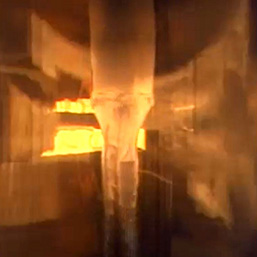At TRiKUC, we focus on the following research topics on various quantum materials:
(1) Unconventional superconducting states in the ruthenium oxide superconductor Sr2RuO4
(2) Development of superconductors related to topological materials, and
(3) Exploration of novel physical properties emerged under uniaxial pressure.
We conduct our research on these themes by synthesizing new materials, growing pure single crystals, developing uniaxial pressure apparatuses, and measuring physical properties down to low temperatures below 1 Kelvin.
1. Unconventional superconductivity of Sr2RuO4
Growth of a Sr2RuO4 single crystal by a floating-zone method. Shiny flat surfaces are the basal facets parallel to the RuO2 plane. The feed rod (top) has a diameter of 5.5.mm.

Ending the growth; disconnecting the feed rod (top) from the crystal (bottom).
The superconductivity of Sr2RuO4 was discovered by us as the first copper-free superconductivity with the same crystal structure as the high-temperature superconductors of copper oxides. Based on various experiments using ultrapure single crystals and advanced theories, it was initially thought that spin-triplet chiral p-wave superconductivity were realized. However, in 2019, the unconventional d-wave superconductivity became a strong possibility. However, it is not easy to explain such a topological superconductivity in chiral states with broken time-reversal symmetry, and the possibility of novel superconductivity due to spin-triplet electron pairs between different electron orbitals has also been discussed. In order to elucidate such a novel superconducting state, TRiKUC is attempting to obtain conclusive evidence through dramatic changes in superconductivity under unidirectional pressure or in eutectic crystals with Ru metal inclusions. TRiKUC also provides ultrapure single crystals with crystal orientations and shapes suitable for various experiments, and is widely engaged in international collaborative research.
2. Superconductivity in topological materials
Topological matterials are typical examples of quantum matterials. They exhibit topological invariants based on various symmetries of the electron wavefunctions. Our group has so far discovered spin-triplet topological superconductivity that breaks the rotational symmetry of the crystal in carrier-doped topological insulator, and superconductivity in an antiperovskite oxide with the property of a topological crystalline insulator.
We have recently discovered superconductivity in CaSb2, which exhibits a topological electronic state called a “Dirac line node metal” due to its non-symmorphic crystal symmetry. We continue our study to elucidate its anomalous variations of its superconducting transition temperature under pressure.
3. Emergent phenomena under uniaxial pressure
Using the recently developed uniaxial pressure device with piezo-element stacks, it is possible to create qualitatively new electronic states by changing the symmetry of the crystal by straining in one direction. Using this device, we are trying new approaches to voltage-control the functionality of materials, such as superconducting transition, ferroelectric transition, metal-insulator transition, and topological transition.
![]()